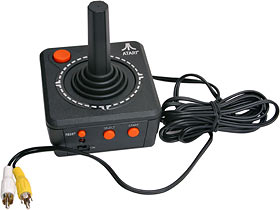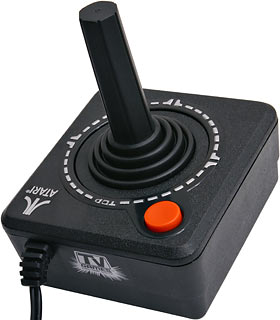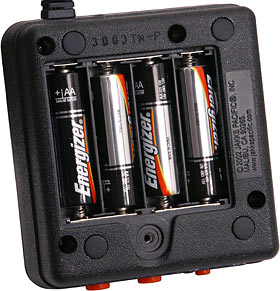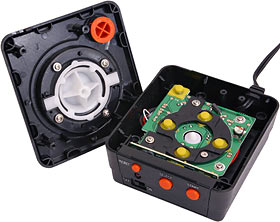
Atari Classics 10-in-1 TV Games
Review date: 28 January 2004.Last modified 03-Dec-2011.
If you wanted to pick the year when nerdiness started becoming cool, you could do worse than choose 1977, on the basis of only two things. Star Wars, and the Atari 2600.
Yes, it took a while after that before nerdiness actually was cool, and the news apparently still hasn't got through to a lot of high school football players. But back in '77, the seeds were planted.
A depressingly large portion of this site's readership wasn't alive in 1977. I was, but I was too young to even have set fire to anything yet.
If you want an easy way to see what cutting-edge home video gaming was like back then...
...you could do a lot worse than buy one of these.
This device is not likely to be news to the gadget-hounds out there; it's been available for more than a year. I'm looking at one now because Australians like me can now buy the thing, in a nice Australian-standard PAL video version, from start-up gadget purveyors LatestBuy. Click here for the product page.
I don't think a one year delay's much to worry about, when the device in question lets you play games that're older than Britney Spears.
The hardware
Electronically, this thing's an Atari 2600. The whole console, in a joystick, with some items deleted (no cartridge slot, no difficulty switches, no colour/BW switch), and ten built-in games.
This "whole console" didn't have very impressive specifications by modern standards, of course. Its CPU was a 1.19MHz MOS Technologies 6507 - a cut-down relative of the 6510 that would later appear in the Commodore 64. Games for the 2600 were originally, limited to only two kilobytes in size.
Do you know what two kilobytes of data gets you these days?

It gets you this.
(Actually, that file's 2062 bytes in size, which is 2.014 kilobytes. Shoo, nitpickers.)
I think you'll agree that a game in 2k - even if it's E.T. - is a much better deal.
Bigger-than-2K 2600 games showed up after a couple of years, using "bank switching" technology to add more 2k ROM blocks. There was only so much that could be done with this, though, given the 2600's meagre 128 bytes of RAM.
Today, some pretty brain-meltingly amazing things have been achieved in only five kilobytes, and there are rice-grain-carvers out there making games as small as 1k, just because. Back before 1980, though, it wasn't just a good idea - it was the law.
You shouldn't believe everything you read, but there's still a quite vibrant Atari 2600 "homebrew" game-making scene, not to mention considerable curiosity about what made the old classics tick, generally among programmers who enjoy feeling like an Airbus engineer looking at a Dreidecker.
The 2600 wasn't the first home game console, but it was the first one to achieve real popularity. Atari sold more than twenty million of the things.
OK, Sony's probably sold an easy 75 million Playstation 2s by now, but on a sales-per-computron basis, the 2600's so far ahead of every modern console that even the Borg would take a million years to get there.
Look at it from the right direction, and the TV Games stick looks like a standard Atari 1010J2/CX-40 joystick, as remembered with at least some degree of fondness by practically every 2600 user.
How iconic is the CX-40? Well, it's what Slashdot use for their "games" icon.
The TV Games unit, loaded with batteries, weighs a bit more than the old plasticky CX-40. But it's still only about 300 grams (10.6 ounces). Quite light enough for kids to use.
Look at the stick from the wrong direction and the extra controls give it away. A power switch and LED, and the Select, Start and Reset buttons; that's all this thing needs.
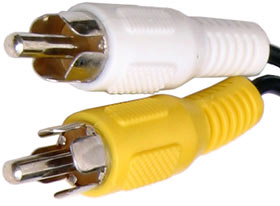
The cable from the stick terminates in a couple of plain RCA plugs, for composite video and mono audio.
In days of yore, game consoles and VCRs connected to TVs via RF modulators, which turned video output into an antenna-cable signal for the TV to tune into. If this sounds inefficient to you, you're right; converting a perfectly good video signal into radio-frequency then converting it back into video for display, when the video source and destination are two feet away from each other, is not a recipe for outstanding image quality.
The TV Games stick's composite output delivers better image quality than any real Atari 2600 can, and is also a more plug-and-go proposition; you don't have to tune the TV to it.
If you've got an old no-video-in TV and a VCR, you can plug the stick into the VCR's line in connectors and use it that way.
The stick runs from four AA cells, and its battery bay door is retained by a screw, to prevent smaller, or drunker, gamers scattering the AAs around the living room.
From six volts, the stick draws about 170 milliamps (mA). This means you should be able to confidently expect at least ten straight hours of play from a set of alkaline AAs, or even more from high-capacity NiMH cells.
The games
The ten games built into the stick are all good - well, by 2600 standards, anyway. You select the game you want to play from a simple on-screen menu.
There is, inescapably, Pong, which is offers very little beyond historical interest these days. This isn't to say that people haven't had some new ideas about this game, but it really ain't gonna float most people's boats today - especially with joystick rather than paddle control, and only one human player.
Still on the very-old-school-classics thread, there's Breakout, and Asteroids, which was the first Atari 2600 game to offer four mighty kilobytes of game code.
There's also the flawed-but-still-legendary Adventure, the similarly classic Yar's Revenge, and the surprisingly-playable-without-a-trackball Centipede and Missile Command.
Want to see what sports games used to look like? RealSports Volleyball was the best 2600 volleyball game, and not just because it was the only 2600 volleyball game.
And then, there's Gravitar (hard to control, but beloved by many connoisseurs), and Circus Atari (like Breakout, only sillier and better).
The stick doesn't have every classic 2600 game, of course. Enthusiasts may mourn the absence of Solaris, which was frankly incredible for its time. Maybe Phoenix, too. Combat would be great, but you'd need two joysticks.
There are plenty of other candidates for a "25-in-one" update. But hey, Solaris is hard, and ten games (only one of which is Pong) ought to do you for a while.
Inside
Undo a few screws, and the 10-in-1 stick's resemblance to the Atari CX-40 abruptly ends. There is, as you'd expect, rather more circuitry inside. And there's also a set of rubber dome switch contacts, which shouldn't need to be periodically dismantled and cleaned like the CX-40's crummy metal domes held in place with sticky tape. Metal-and-tape switches are also found in other old, cheap input devices, like a few late unlamented Commodore mouses.
On the minus side, the rubber dome switches give the joystick very little "feel"; there's no click at all when you push it in a direction. The CX-40 wasn't exactly an ergonomic masterpiece itself, mind you, and plenty of people put up with it for years.
One epoxy blob's the processor; the other one's the game storage.
In the year 2025, a PS2 with ten games will take up the same amount of space.
The damage
The down side of buying the Atari Classics stick from LatestBuy is that they want $AU79.95 for it, plus at least $AU7.95 for delivery. And the batteries aren't even included.
Compared with the US pricing for the NTSC-video model (which'll work fine on a lot of modern PAL TVs; dual-system compatibility is no longer the barrier that it used to be), this is on the high side. ThinkGeek, who aren't exactly renowned for rock-bottom prices, sell the NTSC version of this stick for $US24.99 ex delivery. Shipping to Australia's only an extra $US17.50 or so, so you're talking not much more than $AU55 all up, at the current exchange rate.
But LatestBuy give you a PAL version, and a local warranty, and faster delivery.
$AU80 or so actually ain't a bad price compared with what the 2600 cost way back when. It was $US199 in 1977; that's around $US650 in 2004 dollars.
Casual observers might note, by the way, that LatestBuy's site bears a more than passing resemblance to that of the well-established UK techno-toy dealers, Firebox. Same basic layout, considerable product range duplication, and... identical demo movie files.
Nobody's getting ripped off, though. LatestBuy and Firebox "work very closely" together.
Who makes it
In case you care, the 10-in-1 stick is made by Jakks Pacific. The main Jakks site has no info about their games-in-sticks, but it does feature an excellent picture of a kid who is either rather improbably excited by a 25 year old version of Breakout, or has just been shot.
Jakks have a separate site for games-in-sticks. That site currently showcases the newer Namco stick, which LatestBuy tell me they'll be stocking shortly.
Overall
If you want an express ticket back to the days when game boxes and cartridges tended to be adorned with fanciful painted illustrations that looked absolutely exactly like the in-game graphics, provided you prepared appropriately before playing, the Atari Classics 10-in-1 TV Games stick is that ticket.
You don't have to be an old gamer to dig it, though. It's an elegant product, ultra-portable, and likely to be a hit at parties.
The cheapest way to 2600 fun, for people who already have a PC, is an emulator. But you can't beat the convenience of just plugging a joystick into your TV.
Recommended.
Review Atari Classics 10-in-1 TV Games kindly provided by LatestBuy.
